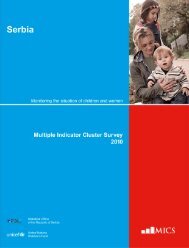concept of vocational education and training in serbia - vet reform ...
concept of vocational education and training in serbia - vet reform ...
concept of vocational education and training in serbia - vet reform ...
Create successful ePaper yourself
Turn your PDF publications into a flip-book with our unique Google optimized e-Paper software.
especially forms <strong>of</strong> active teach<strong>in</strong>g <strong>and</strong> various comb<strong>in</strong>ations <strong>of</strong> theoretical teach<strong>in</strong>g <strong>and</strong>pr<strong>of</strong>essional practice. In this process it is important to obta<strong>in</strong>:• a satisfactory balance among general <strong>and</strong> <strong>vocational</strong> <strong>education</strong>, pr<strong>of</strong>essionaltheoretical <strong>education</strong> <strong>and</strong> pr<strong>of</strong>essional practice;• Vertical <strong>and</strong> horizontal mobility with<strong>in</strong> a curriculum <strong>and</strong> with<strong>in</strong> the frames <strong>of</strong> one ormore fields <strong>of</strong> work;• Introduction to the module work<strong>in</strong>g pr<strong>in</strong>ciple <strong>of</strong> either VET as a whole <strong>in</strong> all fields <strong>of</strong>work or <strong>in</strong> the frames <strong>of</strong> <strong>in</strong>dividual VET schools <strong>and</strong> <strong>education</strong>al <strong>in</strong>stitutions;• L<strong>in</strong>ks with higher forms <strong>of</strong> <strong>education</strong> <strong>and</strong> provid<strong>in</strong>g opportunity for higher<strong>education</strong>Accord<strong>in</strong>g to these pr<strong>in</strong>ciples the basic tasks <strong>of</strong> the unique curriculum <strong>of</strong> secondary VETare oriented to provide knowledge <strong>and</strong> skills both to students <strong>and</strong> adults. The unique curriculum<strong>of</strong> secondary VET must enable:• personal development <strong>of</strong> participants <strong>in</strong> the <strong>education</strong>al process,• quality improvement <strong>of</strong> the level <strong>of</strong> knowledge, skills <strong>and</strong> attitudes (workcompetency) <strong>of</strong> an <strong>in</strong>dividual for perform<strong>in</strong>g jobs;• meet<strong>in</strong>g the needs <strong>of</strong> work process concern<strong>in</strong>g <strong>vocational</strong> attitudes <strong>and</strong> workcompetencies;• Promot<strong>in</strong>g employment <strong>and</strong> lifelong learn<strong>in</strong>g.Process<strong>in</strong>g <strong>of</strong> the whole curriculum at the school level must enable the development <strong>and</strong>improvement <strong>of</strong> work<strong>in</strong>g abilities <strong>of</strong> students <strong>and</strong> adults that give them the possibility for furtherpr<strong>of</strong>essional <strong>and</strong> <strong>education</strong>al development.Learn<strong>in</strong>g – central activity <strong>of</strong> secondary VETLearn<strong>in</strong>g is the central activity both <strong>of</strong> the <strong>in</strong>dividuals <strong>and</strong> <strong>of</strong> schools. It must enable theacquisition <strong>of</strong> knowledge <strong>and</strong> skills <strong>in</strong> the context <strong>of</strong> certa<strong>in</strong> subjects, or contents <strong>and</strong> knowledge<strong>and</strong> skills <strong>of</strong> learn<strong>in</strong>g itself.Development <strong>of</strong> <strong>in</strong>formation technology, economy <strong>and</strong> bus<strong>in</strong>ess have altered traditionalwork-practice <strong>and</strong> dem<strong>and</strong> different abilities <strong>and</strong> skills – not only pr<strong>of</strong>essional/technical “knowhow”but first <strong>of</strong> all the ability to create, analyse <strong>and</strong> transform <strong>in</strong>formation <strong>and</strong> <strong>in</strong>teracteffectively with others. The learn<strong>in</strong>g becomes a lifelong activity. Under these new circumstanceslearn<strong>in</strong>g skills become especially important for the students <strong>and</strong> adults. Learn<strong>in</strong>g skills shouldenable students <strong>and</strong> adults to acquire knowledge, use <strong>and</strong> process<strong>in</strong>g <strong>of</strong> <strong>in</strong>formation, to transferthis <strong>in</strong>formation <strong>in</strong>to new knowledge, skills <strong>and</strong> values, development <strong>of</strong> abilities to work withothers, learn with <strong>and</strong> from others.Learn<strong>in</strong>g skillsInformation <strong>and</strong>Communication SkillsInformation <strong>and</strong> media literacy skills:Analys<strong>in</strong>g, access<strong>in</strong>g, manag<strong>in</strong>g, <strong>in</strong>tegrat<strong>in</strong>g,evaluation <strong>and</strong> creat<strong>in</strong>g <strong>in</strong>formation <strong>in</strong> a variety<strong>of</strong> forms <strong>and</strong> media.Communication skills:Underst<strong>and</strong><strong>in</strong>g, manag<strong>in</strong>g <strong>and</strong> creat<strong>in</strong>g effectiveoral, written <strong>and</strong> multimedia communication <strong>in</strong> avariety <strong>of</strong> forms <strong>and</strong> context.22
















